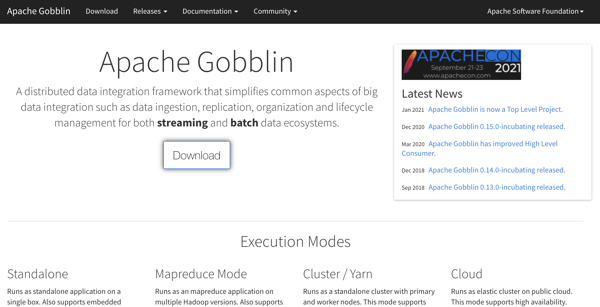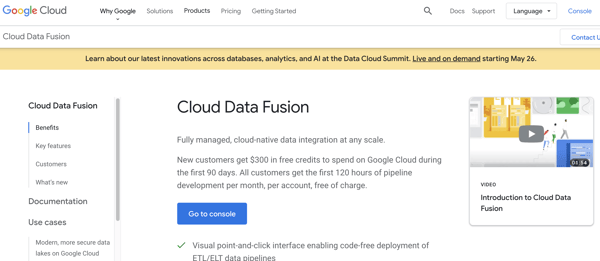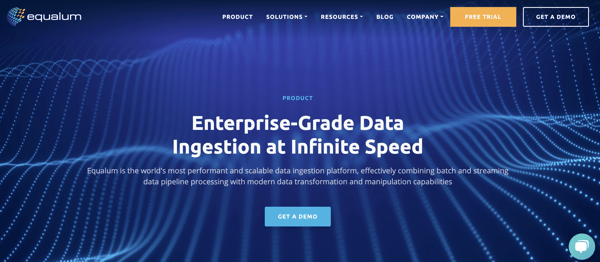- Like
- SHARE
- Digg
- Del
- Tumblr
- VKontakte
- Flattr
- Buffer
- Love This
- Save
- Odnoklassniki
- Meneame
- Blogger
- Amazon
- Yahoo Mail
- Gmail
- AOL
- Newsvine
- HackerNews
- Evernote
- MySpace
- Mail.ru
- Viadeo
- Line
- Comments
- Yummly
- SMS
- Viber
- Telegram
- JOIN
- Skype
- Facebook Messenger
- Kakao
- LiveJournal
- Yammer
- Edgar
- Fintel
- Mix
- Instapaper
- Copy Link
A scaling business is bound to have data stored across multiple sources (e.g. databases, files, live data feeds). Even individual teams within a department — such as Content Marketing, Brand Strategy, and SEO — likely use multiple data sources simultaneously.
It’s important to ensure you have a way of viewing, visualizing, and analyzing all of that data at once. This gives you a complete picture of the health of everything related to your business, from small projects to team projections to overall business success.
Data ingestion is the process that can efficiently get all of your data in one place.
Data Ingestion
At a high level, data ingestion prepares your data for analysis. In this blog post, we’ll cover the definition of data ingestion in greater detail, describe its importance, review the data ingestion framework, and highlight a few tools that will make the process simple for your team. Let’s dive in.
What is data ingestion?
Data ingestion prepares your data for analysis. It’s the process of transporting data from a variety of sources into a single location — often to a destination like a database, data processing system, or data warehouse — where it can be stored, accessed, organized, and analyzed.
This process allows businesses to get a holistic view of their data in order to leverage and apply resulting insights and findings in their strategies.
Why is data ingestion important?
You may be wondering why data ingestion is so important and why your marketing team — and business as a whole — should leverage it.
As mentioned, data ingestion provides a single view of all of your data. Without the ability to access, review, and analyze all of your data at the same time — versus having to check multiple data sources which visualize your data in different formats — you wouldn’t have a clear or accurate picture of what’s doing well and what needs to be improved upon.
Data ingestion tools exist to make this process even easier by automating the process of integrating all of your data from various sources. This way, anyone on your team can access and share that data in a format and via a tool that are universal among your organization.
Data Ingestion Framework
The data ingestion framework is how data ingestion happens — it’s how data from multiple sources is actually transported into a single data warehouse/ database/ repository. In other words, a data ingestion framework enables you to integrate, organize, and analyze data from different sources.
Unless you have a professional create your framework for you, you’ll need data ingestion software to make the process happen. Then, the way that the tool ingests your data will be based on factors like your data architectures and models.
There are two main frameworks for data ingestion: batch data ingestion and streaming data ingestion.
Before we define batch versus streaming data injection, let’s take a moment to decipher the difference between data ingestion and data integration.
Data Ingestion vs. Data Integration
Data integration takes data ingestion a step further — rather than just stopping after the data is transported to its new location/ repository, data integration also ensures all data, no matter what type it is or which source it came from, is compatible with each other as well as the repository it was transported to. That way, you can easily and accurately analyze it.
1. Batch Data Ingestion
The batch data ingestion framework works by organizing data and transporting it into the desired location (whether that’s a repository, platform, tool etc.) in groups — or batches — periodically.
This is an effective framework unless you have large quantities of data (or are dealing with big data) — because, in those instances, it’s rather a rather slow process. It takes time to wait for batches of data to be transported and you wouldn’t have real-time access to that data. However, this is known to be a cost-effective option due to the fact it requires few resources.
2. Streaming Data Ingestion
A streaming data ingestion framework transports data continuously and the moment it’s created/ the system identifies it. It’s a helpful framework if you have a lot of data that you need access to in real-time, but it is more expensive due to the capabilities that batch processing doesn’t have.
Data Ingestion Tools
Data ingestion tools integrate all of your data for you — no matter the source or format — and house it in a single location.
Depending on the software you choose, it may only perform that function, or it may assist with other aspects of the data management process, such as data integration — which entails transforming all data into a single format.
1. Apache Gobblin
 Apache Gobblin is a distributed data integration framework and it’s ideal for businesses working with big data. It streamlines much of the data integration process, including data ingestion, organization, and lifecycle management. Apache Gobblin can manage both batch and streaming data frameworks.
Apache Gobblin is a distributed data integration framework and it’s ideal for businesses working with big data. It streamlines much of the data integration process, including data ingestion, organization, and lifecycle management. Apache Gobblin can manage both batch and streaming data frameworks.
2. Google Cloud Data Fusion

Google Cloud Data Fusion is a fully managed, cloud data integration service. You can ingest and integrate your data from a number of sources and then transform and blend it with additional data sources. This is possible because the tool comes with many open-source transformations and connectors which work with various data systems and formats.
3. Equalum

Equalum is a real-time, enterprise-grade data ingestion tool that integrates batch and streaming data. The tool collects, manipulates, transforms, and synchronizes data for you. Equalum’s drag-and-drop UI is simple and doesn’t require code so you can create your data pipelines quickly.
Start Using Data Ingestion
Data ingestion is a critical aspect of data management — it ensures all of your data is accurate, integrated, and organized so that you can easily analyze it on a large scale and get a holistic view of the health of your business.
Originally published Sep 2, 2021 7:00:00 AM, updated September 02 2021

![Download Now: 2021 State of RevOps [Free Report]](https://no-cache.hubspot.com/cta/default/53/78dd9e0f-e514-4c88-835a-a8bbff930a4c.png)


